TREES, c.1950
GODFREY MILLER
oil and pencil on canvas
90.0 x 80.0 cm
bears inscription on frame verso: Blue Unity series c.1950
Estate of the artist, Sydney
Estate of John Henshaw, Sydney (ref. JH 296)
Charles Nodrum Gallery, Melbourne
Private collection, New South Wales
Thence by descent
Private collection, New South Wales
Godfrey Miller, Charles Nodrum Gallery, Melbourne, 10 June – 3 July 2010, cat. 1 (illus. on exhibition catalogue front cover)
While Godfrey Miller held his place amongst modernist painters of his time, an aversion to exhibiting or releasing his works from the studio stunted the arc of his career during his lifetime. Most of Miller’s major works are held in institutions as he was reluctant to sell to private collectors, except on rare occasions for important individuals whom he felt worthy of owning his works.
Miller’s paintings represent the true spirit of an artist whose sole focus in life was the pursuit of truth and beauty through his work. His mature paintings are characterised by his use of fine, ruled lines, which segment the surface into small geometric fields poised to receive pockets of colour oil wash. The artist’s working methods were such that it may have felt impossible for Miller to actually finish a painting. His forensic attention to detail meant that each additional application of colour, no matter how minor, would send a kaleidoscopic ripple across the work, which the artist would intuitively be required to follow with further counter strokes, resulting in a perpetual game of aesthetic adjustment. From early in his career, Miller was known to take up to fifteen years to complete a work.
The subject of trees was an enduring one for Miller. The parallels between forests of trees and architecture, essentially in scale and structure, suited his requirements. In his unending quest for unity between subject, ground and medium, he developed a method of weaving and layering his subjects with the surrounding space. Through merging natural and manmade forms, he succeeded in creating works of enormous technical complexity.
In the present work the artist depicts a forest of trees, which he transforms to represent a gothic cathedral with its lurching arabesques and receding perspective. Miller’s delicate angular divisions take on the appearance of stained glass, adding to the similarity. His limited palette of phthalo blue and viridian green across a range of tones creates cool passages which work to project the areas painted in warm vermillion red forward. His choice of complimentary colour opposites conspires to create pictorial space with both volume and depth. The cathedral opens in the lower area of the picture where a series of diagonal shafts of light beam into the foreground, creating a nave-like focal point for the work which provides a reprieve from the dense canopy which dominates the painting. In his adopted home town of Sydney, Miller’s work grew apart from the lyrical abstraction which prevailed through the teaching at East Sydney Technical College. While the influential John Passmore and his students danced to the tune of Cézanne, Godfrey Miller stayed true to his intuition: his rigid analytical propositions representing not only a milestone of Australian painting, but a profoundly personal vision.
HENRY MULHOLLAND
